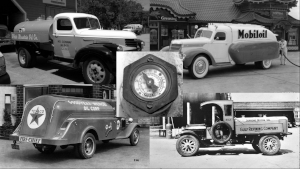In mid-October 2017, the Governor of Nebraska received notification from the U.S. Department of Energy's (USDOE's) Energy Information Administration (EIA) that the Midwest's propane stocks were below the five–year average for the fourth consecutive week based on the latest EIA data.
Winter Recap
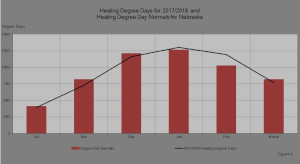
click/tap to enlarge
The 2017/2018 winter heating season saw normal winter temperatures. Areas in Nebraska felt the impact from Winter Storms Dylan (December 22, 2017), Ethan (December 24, 2017), Frankie (December 29, 2017), Jaxon (January 22, 2018), April Fool's Snowstorm (March 31–April 1, 2018), and Xanto (April 13–14, 2018). Winter Storms Jaxon and Xanto were ultimately classified as blizzards.
In mid-October 2017, the Governor of Nebraska received notification from the U.S. Department of Energy's (USDOE's) Energy Information Administration (EIA) that the Midwest's propane stocks were below the five–year average for the fourth consecutive week based on the latest EIA data. The Nebraska Energy Office increased monitoring and communication with marketers, the propane association, fuel terminals, Energy Emergency Assurance Coordinators in adjacent states, the USDOE, and pipelines. The Reliable Home Heating Act of 2014 requires EIA to notify Governors of affected states whenever stocks of heating fuels, including propane/propylene, fall below five–year average levels for more than three consecutive weeks.
On December 30, 2017, the Federal Motor Carrier Safety Administration (FMCSA) issued a Regional Emergency Declaration followed by three extensions resulting in an expiration date of February 28, 2018. (The extensions were due to the emergency conditions not abating.) The Emergency Declaration responded to emergency conditions created as a result of Winter Storm Frankie, including anticipated fuel shortages in the affected states and jurisdictions, which expected to create a need for immediate transportation of propane and home heating oil and fuels, into and from the affected states and jurisdictions and to provide necessary relief. In short, the Emergency Declaration was in response to anticipated home heating fuel shortage due to Winter Storm Frankie, severe weather, and the demand for increased usage. The affected states and jurisdictions included 37 states, of which Nebraska was one, and the District of Columbia.
In Nebraska, the most urgent propane shortages were on one pipeline with five terminals in the state. A majority of the time, there was no propane at four of their terminals. And the fifth terminal was running short because everyone was going there to try to get propane. Suppliers estimated that supply would be available in a few days, but that created a ripple effect due to the interdependencies. The companies that usually got product at the empty terminals drove to the fifth terminal, which caused an even earlier shortage. Plus drivers were using all of their drive time sitting in line at the terminal. Drivers who could normally get two to three loads in a day were only getting one load before they were maxed out of time. It was expected that customers would soon see rationing in order to ensure having at least some propane for heat. Shortages in surrounding states were having a ripple effect in Nebraska, too. South Dakota, Iowa, Missouri, and Kansas had severe supply shortages which affected marketers in Nebraska. These states were additional competition for propane at the fifth terminal already inundated by additional Nebraska companies.
As a result of cold temperatures and logistics issues, the average price of propane was 22 percent higher than last season. Propane is an important fuel source in Nebraska and its use is estimated at 7 percent. Propane prices are subject to both the volatility of the oil markets and natural gas production. Heating oil prices continue to be highly dependent on crude oil market movements. Heating oil prices were 10 percent lower than last winter's heating season due to adequate stocks. Heating oil retains a smaller market share in Nebraska, estimated at less than one percent (0.34%).
The traditional heating season for both heating oil and propane is October through March. From October through March, Nebraska normally has 5520 heating degree days. For this period during the 2017/2018 winter season, Nebraska had 5550 heating degree days which indicates that the weather was less than 1 percent cooler than normal—pretty much a normal cold winter. In Figure 1, the bars represent the heating degree day results of normal winter weather for each month in Nebraska. The line represents the heating degree day results of the actual weather that the 2017/2018 winter season experienced. The higher the number of heating degree days, the colder the weather, and the more days Nebraskans had to heat their homes and businesses. Each month shows that this winter season's heating degree days were very close to the normal number of heating degree days.
Purpose of Survey
The Nebraska Energy Office collects data on residential prices of No. 2 heating oil and consumer–grade propane during the heating season (October to March) for the State Heating Oil and Propane Survey (SHOPP). It is the only USDOE EIA survey that collects propane prices. The data are used by the Nebraska Energy Office to monitor the prices of propane and heating oil during the winter season in an effort to maintain awareness of any price or supply irregularities that may be developing.
Residential Propane
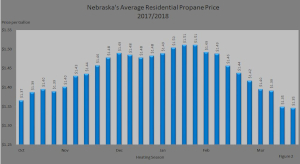
click/tap to enlarge
The price of propane is closely tied to the price of crude oil and natural gas––more so to natural gas in the last heating season. It is estimated that over half of propane supply is now sourced from natural gas processing facilities. In the past, supply was at least 50 percent from crude oil refining operations which resulted in increased volatility and higher prices. Normal winter weather can also put extra pressure on propane prices during the high–demand winter season since there are no readily available sources of increased supply except for imports. Canadian propane supply is always reviewed due to the panhandle of Nebraska relying on Canadian imports. Exports are also a cause for concern for many. The Oil Price Information Service (OPIS) reported at the beginning of the winter season (October 2017) that exports of propane and propylene, according to EIA data, averaged 844,000 barrels/day so far that year. This compares with 717,000 barrels/day exported in 2016 during the same time period and a five–year average of 395,000 barrels/day.
The average home heating charge price for delivery of consumer–grade propane, excluding taxes and cash discounts, in Nebraska for the 2017/2018 heating season was $1.44 per gallon. This was a 22–percent increase from last season's average price at $1.18.
For the 2017/2018 season, the average retail price of propane started at $1.37 per gallon. The average price increased slightly until it reached $1.51 for a couple of weeks at the end of January. Each week through February and March, the average price fell ending the heating season at $1.35 per gallon. This price was relatively equal to (2 cents lower) the price at the beginning of the heating season. Prices reported on the survey each week were dependent upon when a marketer bought a load of propane from their supplier. After buying a load of propane, the price would reflect the wholesale price paid. (See Figure 2.)
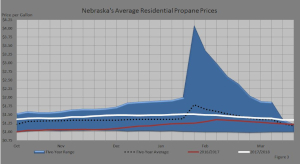
click/tap to enlarge
The average propane price began the 2017/2018 heating season at $1.37, 37 cents higher than the price of $1.00 at the beginning of the last heating season. As shown in Figure 3, the average propane prices in the 2017/2018 season were stable within the five–year range but higher than the five–year average and last year's prices.
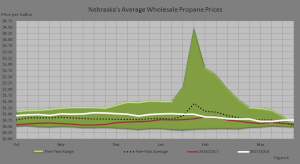
click/tap to enlarge
The average wholesale propane price began the 2017/2018 heating season at 94 cents, which was 36 cents higher than the price of 58 cents at the beginning of the last heating season. Average wholesale propane prices declined through the heating season. The price finished the 2017/2018 heating season at 76 cents, which was 18 cents lower than the price at the beginning of the heating season. As Figure 4 shows, the average price of wholesale propane was relatively stable during the heating season staying in the five–year range although the average price was much higher than last season's wholesale price. The wholesale price was above and below the five–year average during this heating season.
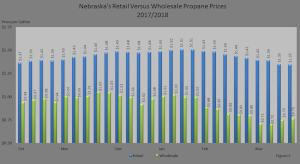
click/tap to enlarge
A comparison of average retail propane prices versus average wholesale propane prices in Figure 5 shows that retail prices during the 2017/2018 heating season ranged from a low of $1.35 to a high of $1.51, while wholesale prices ranged from a low of $0.70 to a high of $1.05. Retail prices are higher than wholesale prices since wholesale prices are just a major component in retail prices. Retail prices also parallel wholesale prices.
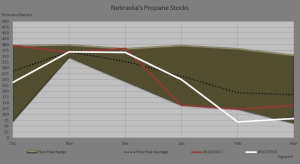
click/tap to enlarge
As shown in Figure 6, propane stocks began the 2017/2018 heating season in the middle of the five–year range but below the five–year average and far below last year's beginning level. Propane–consuming petrochemical plants, export facilities, and the entire distribution system were not fully operational in late August into September after Hurricane Harvey. The Midwest and Nebraska still had adequate propane supply due to the lowered demand from grain drying, low precipitation, and the cost of propane being high relative to corn prices. Stocks in Nebraska were high through January whereupon the levels fell in February below 75,000 barrels and only rose slightly in March. According to EIA, Nebraska's total inventory of propane was approximately 238,000 barrels at the beginning of the heating season in October 2017, 160,000 barrels below propane stocks one year earlier. Nebraska stocks remained in the five–year range throughout the heating season, gradually declining with higher demand in February and March. Overall, cold temperatures left propane stocks at 83,000 barrels at the end of March 2018, 55 percent below the five–year average for that period.
Residential Heating Oil
The price of heating oil, being a petroleum product, is closely tied to the price of crude oil. Normal winter weather can also put extra pressure on heating oil prices during the high–demand winter season.
The average home heating charge price for delivery of No. 2 heating oil, excluding taxes and cash discounts, in Nebraska for the 2017/2018 heating season was $1.79 per gallon. The season's average price fell 20 cents or 10 percent from last season's average of $1.99.
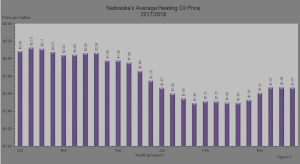
click/tap to enlarge
Figure 7 shows that the average retail price of heating oil started the 2017/2018 season at $2.09 per gallon. The price was relatively stable from October through the first week of December. From then on, the price fell slightly each week until the last week of January when it hit its low at $1.49 per gallon. After that, the price was stable until rising to $1.88 the third week of March. By the end of the heating seaon, Nebraska's average price was $1.67, 42 cents lower than the price at the beginning of the season.
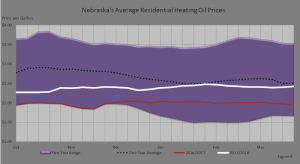
click/tap to enlarge
The average heating oil price began the 2017/2018 heating season at $2.09, 15 cents higher than the price of $1.94 at the beginning of the last heating season. Average heating oil prices were relatively stable throughout the heating season. As Figure 8 shows, the average price of heating oil took a sizable jump above last year's price at the beginning of the heating season and remained there for the season. Heating oil prices started in the lower area of the five–year range and improved through the heating season to the midrange. The prices were under the five–year average all season.
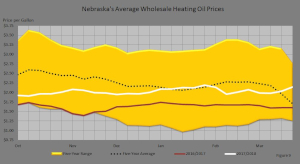
click/tap to enlarge
The average wholesale heating oil price began the 2017/2018 heating season at the lower range of the five–year range but improved (as the retail prices did) to midrange through most of the season. As Figure 9 shows, the average price of wholesale heating oil was relatively stable during the heating season staying in the five–year range although the average price was much higher than last season's wholesale price. The wholesale price was above and below the five–year average during the heating season. The average price of wholesale heating oil started the heating season at $1.92, which was 24 cents higher than the price of $1.68 at the beginning of the last heating season. By the end of the heating season, Nebraska's average wholesale heating oil price was $2.14, which was 22 cents higher than the price at the beginning of the heating season.
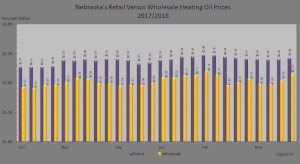
click/tap to enlarge
A comparison of retail heating oil prices and wholesale heating oil prices in Figure 10 shows that, during the 2017/2018 heating season, retail prices ranged from a low of $1.85 to a high of $2.05, while wholesale prices ranged from a low of $1.40 to a high of $1.74. Retail prices are higher than wholesale prices since wholesale prices are just a mjaor component of retail prices. Retail prices also parallel wholesale prices.
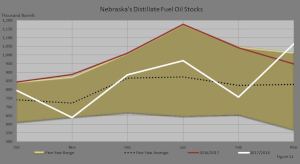
click/tap to enlarge
Figure 11 shows distillate stocks in Nebraska. Distillate stocks were in the range of 600,000 barrels to slightly above 1 million barrels throughout the heating season. Stocks started the season in the upper five–year range and above the five–year average, but below last year's inventory level. Stocks rose and fell throughout the season before ending in March on a high note at 1,065,000 barrels––which was above the five–year range, the five–year average, and last year's level.
Sources: State Heating Oil and Propane Survey and the Weekly Petroleum Status Report. Energy Information Administration, Washington, DC. Nebraska Energy Office, Lincoln, NE.
This report was completed October, 2018.

